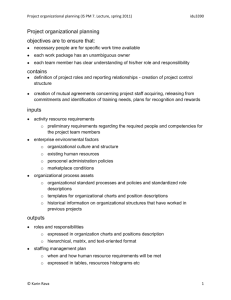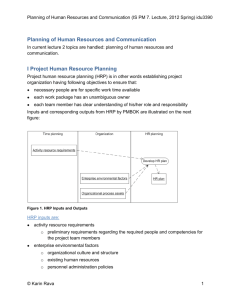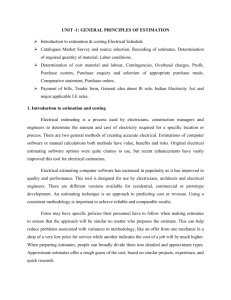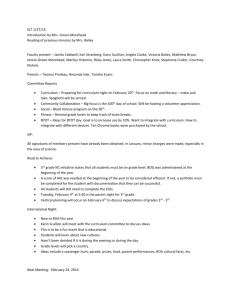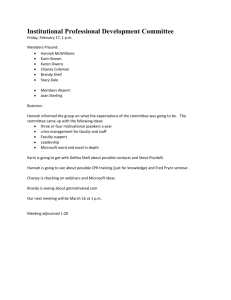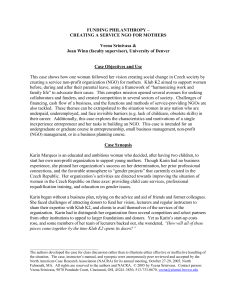Planning of Project Work Project time (usage) planning in PMBOK
advertisement
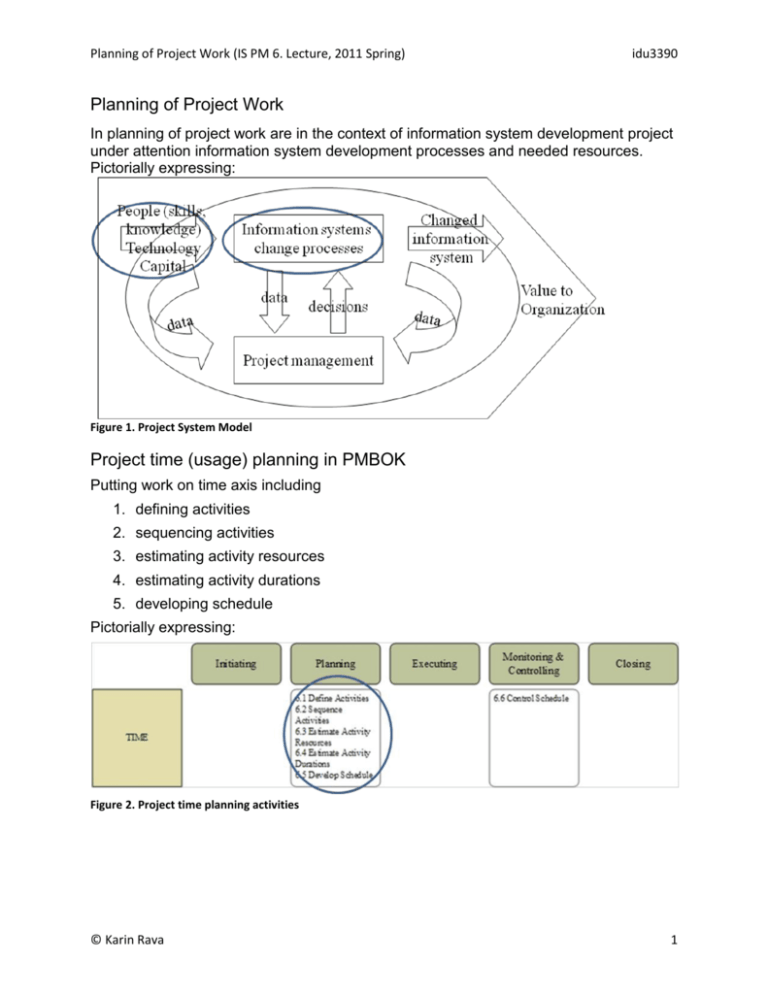
Planning of Project Work (IS PM 6. Lecture, 2011 Spring) idu3390 Planning of Project Work In planning of project work are in the context of information system development project under attention information system development processes and needed resources. Pictorially expressing: Figure 1. Project System Model Project time (usage) planning in PMBOK Putting work on time axis including 1. defining activities 2. sequencing activities 3. estimating activity resources 4. estimating activity durations 5. developing schedule Pictorially expressing: Figure 2. Project time planning activities © Karin Rava 1 Planning of Project Work (IS PM 6. Lecture, 2011 Spring) idu3390 More closer: Figure 3. Project time planning activities more closely The Basis for time planning Project scope – o product conceptual design + o requirements for achieving project objectives Work / deliverables breakdown structure Arrangement of work processes o methodology or development strategy + o development process Step 1 – defining activities Decomposing the WBS work packages into activities where work packages are evaluated for how they can be broken down into manageable activities. © Karin Rava 2 Planning of Project Work (IS PM 6. Lecture, 2011 Spring) idu3390 The output of that process is the complete list of project activities - activity list - each activity should have a unique identifier that correlates it to the WBS work package An adequate level of activity decomposition is generally reached when the activities: are assignable to one person can have a level of effort determined for them can have their resource needs estimated can have their expected costs reasonably established can have their progress determined and tracked Every activity must be fully described containing: explanations of any special dependencies or relationships that exist assumptions that were made person responsible for the activity special equipment or materials needed information specific to the activity that will vary depending upon the project's application area and the type of activity Activity types categorize how measurable the activity is and how it’s related to the project’s objectives: discrete effort - a discrete effort activity is one whose work directly relates to a work package or deliverable on the work breakdown structure. These types of activities need to be measurable since they tie directly to the project’s core objectives. level of effort (or LOE) - is usually an activity performed by a supporting role that is difficult to measure, but is still related to the project’s core objectives. apportioned effort (or AE) - activity is one which is usually related to project management –it’s necessary for the efficient functioning of the project, but it isn’t directly related to the project’s final product, service, or result. Another important output of activity definition is the milestone list which provides all significant events and dates on the project. Time periods between milestones are defined as phases or iterations Defining milestones Milestones provide a very effective method for communicating the schedule progress to stakeholders. They are description of the states of the project at a certain point of time. They can be points at which major deliverables are completed, phases are reached, or other important dates. The last milestone in project is the point where project stakeholders formally decide to accept the ownership of project results Milestone describes what the project should achieve, not how. It should be neutrally formulated with regard to the solution - we must have freedom to choose the activities to © Karin Rava 3 Planning of Project Work (IS PM 6. Lecture, 2011 Spring) idu3390 reach the desired state, for example: “members have specified knowledge in a stated area” or “members have completed course X” There are major milestones – important events to customer and minor milestones – important events to project team(s) Examples of software development milestones are presented in the following table: Table 1. Example of milestones in software development Milestone Criteria Feature freeze System test freeze Beta ship The date when all required features are known and the detailed design has uncovered no more. No more features are inserted into the product. Implementation of the design has stopped. Some testing of the features has occurred. Integration testing is complete. Code freeze for system test to start. The date the Beta software ships to Beta customers Product ship The date the product ships to the general customer base Code freeze Defining phases The time between two major project milestones, during which a well-defined set of objectives is met and artifacts are completed – group of activities. They provide project stakeholders with the opportunity to make significant decisions about committing resources to the project, one step at a time. Each phase must be concluded with a formal milestone decision - the point at which stakeholders must decide to commit resources to achieve the objectives of the next phase (not the entire project!) Phases in turn are refined in smaller time periods (iterations) having same features than phases. Step 2 – sequencing activities Sequencing activities involves determining the dependencies and relationships between activities and applying leads and lags. The result is a project network - logical structure of successive project activities at the end of what must be achieved certain project objectives/results. © Karin Rava 4 Planning of Project Work (IS PM 6. Lecture, 2011 Spring) idu3390 Activity sequences are shown through project schedule network diagrams which schematics are showing the order and relationships of project activities. Dependences between activities may be hard logic – we can perform an activity when preceding activity or activities are finished related with resources availability – performing an activity is possible when needed resources are available Leads and lags are artificial effects on the timing of activities and are used in conjunction with activity relationships and dependencies. Leads and lags and the reasoning behind their use should be well documented because it may not be obvious to the casual observer why they were established Lags are delays or waiting time between activities - positive time added to an activity's duration Leads speed up activities without changing the relationships between the activities “negative” time because they allow activities to occur in parallel that would normally be done sequentially Task link types They are presented in the following table: Table 2. Task link types Name Finish – to – start (FS) Semantics A must finish before B starts Start – to – start (SS) – A must start before B can start Finish – to – finish (FF) A must finish before B can finish Start – to – finish (SF) A must start before B can finish © Karin Rava Pictorially 5 Planning of Project Work (IS PM 6. Lecture, 2011 Spring) idu3390 Step 3 – estimating activity resources Identifying the quantities of resources needed for the project’s activities. Resources are anything having a monetary cost and include materials, equipment, licenses, fees, and personnel needed for the project’s activities. The quantity designations will depend upon the type of resource: resource quantities for personnel may be expressed in hours, work days, or work weeks the quantity designations for materials to be consumed will be expressed in whatever unit is applicable (cases, boxes, pounds, tons, kilograms, and so on) quantity designations for equipment or facilities would likely be expressed as a unit of time (hours, weeks, or months) Estimating methods Top-down estimating form of expert judgment through which an item is looked at broadly and a generalized estimate created Bottom-up estimating provides estimates for each component activity, and then aggregates these into an overall estimate Estimating accuracy Rough order of magnitude estimate - these are usually top-down estimates made by expert judgment. The variance range for this type of estimate is expected to be -25% to +75% of the final actual figure Budget estimate - these have less variance than rough order of magnitude, but they are still broad estimates. The variance range for this type of estimate is expected to be -10% to 25% of the final actual figure Definitive estimate - this type is the most accurate estimate. The variance range for this type of estimate is expected to be -5% to 10% Using calculation method Number of personnel = work size (effort) in hours / time period available to overall project o Work size is 800 hours o Project duration is 50 work days o Size of 1 work day is 8 hours o 800/ (50*8)=2 Using PERT (Program Evaluation and Review Technique) method Optimistic estimation (OE), most likely estimation (MLE), pessimistic estimation (PE) for personnel need o Weighted average estimation (WAE) = (OE+4*MLE+PE)/6 © Karin Rava 6 Planning of Project Work (IS PM 6. Lecture, 2011 Spring) idu3390 Step 4 – estimating activity duration How long the activity will take expressed in a work period (day, hour). Usually number of days where 1 or more resources actually at the activity work The bases for duration estimation are size of effort, number of resources and work hours of every resource per work day Estimation methods: Using calculation method: duration = effort size/ resource quantity / resources work hours number per work day, for example: 10 hours effort / 2 people / 2 hours per work day = 2,5 Using PERT (Program Evaluation and Review Technique) method (calculating weighted average duration) - WAE = (OE+4*MLE+PE)/6 Estimating project effort The labor required to deliver a product of a given size. Effort is measured in personhours, person-days, or person-months. For example: for strategic analysis 500 hours or 60 work days or 3 months Effort Estimation Methods Calculating size - sizing by analogy or sizing by analysis where sizing by analogy is based on experiences from previous projects. Sizing by analysis - Function Point Counting, Feature Points, Predictive Object Points, Use Case-s, Story Points etc Algorithmic software cost estimation model COnstructive COst MOdel (COCOMO) program size is expressed in estimated thousands of lines of code (KLOC) Step 5 – schedule development Schedule development with its inputs, outputs and techniques is presented on the following figure: © Karin Rava 7 Planning of Project Work (IS PM 6. Lecture, 2011 Spring) idu3390 Figure 4. Schedule development inputs, outputs and techniques RUP phases and their objectives Are expressed in the next table: Table 3. RUP phases and their objectives Phase Inception Objectives Gain stakeholder agreement on scope and boundary conditions Economically motivate the project. Ensure mutual understanding of critical functionality. Produce overall estimates of cost and schedule. Gain insight into risks that may threaten project success. Elaboration Demonstrate that the system architecture will satisfy the significant constraints imposed on the product. Achieve stability of the product vision. Produce a realistic plan for executing the remainder of the project. Eliminate any significant risks that may threaten the success of the project. Construction Build and test the system in increments. Ensure increasing understanding and acceptance of the system by stakeholders. Minimize costs and schedule. Transition Achieve user self-sufficiency. Achieve acceptable operational quality. Transfer ownership of the system to support and maintenance. Evaluate and conclude project. © Karin Rava 8 Planning of Project Work (IS PM 6. Lecture, 2011 Spring) idu3390 Iteration definition A time-boxed period during which one or more teams perform a set of related activities to produce a coherent and (partially) complete product. The rule of thumb by defining iterations in RUP phases: in Inception and Transition phase 1 iteration, in Elaboration and Construction phase 2 iterations, or divide Elaboration and Construction into 4-week iterations and Inception and Transition into 6 week. Every iteration should have specific objectives - they should eliminate risks. Example of iteration objectives is shown in the following table: Table 4. RUP iterations objectives Iteration Inception-1 Elaboration-1 Objectives Achieve stakeholders’ concurrence on scope Refine estimates based on actual experiences during Inception. Identify and prioritize risks. Construct a detailed plan for the remainder of the project. Develop a skeleton solution which covers the complex, volatile, and risky parts of the system. Eliminate highest priority technical risks. Ensure project team proficiency with process and tools. Elaboration-2 Ensure stability of the development and test environments. Develop a skeleton solution with broad functional coverage and depth in only the risky parts. Construction-1 Construction-2 Eliminate all known nontrivial risks. Construct a detailed plan for the remainder of the project. Develop 80 percent of the solution as rapidly as possible with reasonable quality. Minimize costs by optimizing schedule and resources. Develop 100 percent of the solution. Achieve acceptable quality of all developed portions of the solution. Transition-1 Prepare deployment to the end-user and support organization Minimize costs by optimizing schedule and resources. Improve the quality of the solution. Ensure end-user organization ability to use the solution. Ensure support organization ability to support the solution. Close out the project. © Karin Rava 9 Planning of Project Work (IS PM 6. Lecture, 2011 Spring) idu3390 Partition project effort and schedule across phases Is presented in the next table: Table 5. Partition of effort and schedule in RUP phases Partition phase effort and schedule across iterations In order to get schedule and effort of one iteration. In partitioning schedule, it is usually easiest to divide the phase into iterations of equal length or first iterations longer. Same way with partitioning effort. Iterations of equal length within a phase usually require equal effort. Allocate more effort to longer phases and less to shorter ones, so that the total effort per week remains relatively constant within a phase. Pictorially expressing: Table 6. Partition phase effort and schedule across iterations Phase Inception Elaboration Construction Transition Iteration I1 E1 E2 C1 C2 T1 Schedule 4 week 3 weeks 3 weeks 6 weeks 6 weeks 6 weeks Effort 600 hours 700 hours 700 hours 2400 hours 2400 hours 1200 hours Agile planning and estimation Product level – 1-2 times in the year – attention on product creation in time Release level – 3-4 times in the year – attention on compromises concerning features and delivery dates Sprint level – in every iteration – attention on features under development in the frames of sprint © Karin Rava 10 Planning of Project Work (IS PM 6. Lecture, 2011 Spring) idu3390 Every day level – every day – attention on everyday commitment in completing features. Pictorially expressed on the next figure: Figure 5. Agile approach to planning Main elements in agile planning User Story and individual product backlog estimates (Story Points) Release size estimates Velocity – is measured in the units you use to estimate Product Backlog items Team velocity Planning Poker Pictorially: Joonis 6. Elements in agile planning © Karin Rava 11 Planning of Project Work (IS PM 6. Lecture, 2011 Spring) idu3390 Requirements Management in Scrum Figure 7. Requirements management in Scrum Disciplined agile work management process Figure 8. Disciplined agile work management process © Karin Rava 12 Planning of Project Work (IS PM 6. Lecture, 2011 Spring) idu3390 Lean work management process Figure 9. Lean work management process Work management in KANBAN Figure 10. Work management example in KANBAN © Karin Rava 13 Planning of Project Work (IS PM 6. Lecture, 2011 Spring) idu3390 Cost planning Includes cost estimation and budget determination Cost estimation by cost types: direct costs – attributed specifically to a detailed or summary activity of the project indirect costs - incurred by the project, but the goods or services are also used for non-project activities variable costs - fluctuate and can't be predicted with absolute certainty fixed costs are static throughout the project or have only a small likelihood of fluctuation Cost estimation methods: by analogy – order of magnitude (-25% ja +75%) resource cost rate (-10% ja +25%) parametric estimation (-5% ja +10%) Budget determination - cost aggregation by WBS. Every WBS element has its monetary cost Used literature Alex Sherrer, Project Management Road Trip, Ch. 6 - Time Management, http://www.pmroadtrip.com/pmpv4_06.html Alex Sherrer, Project Management Road Trip, Ch. 7 - Cost Management, http://www.pmroadtrip.com/pmpv4_07.html John Filicetti. Project Management Process - Phase 2 - Planning - Develop Project Schedule, http://www.pmhut.com/project-management-process-phase-2-planningdevelop-project-schedule Plan and Schedule Development, http://www.nehimss.org/070518_Project_Management/Chance_Reichel_Templ_Tas kID_WBS_05_12_00.doc Eric Lopes Cardozo, DJ de Villiers. Project planning best practices, The Rational Edge, August 2003, http://www.ibm.com/developerworks/rational/library/content/RationalEdge/aug03/m_ projectplanning_dd_ec.pdf Johanna Rothman, Iterative Software Project Planning and Tracking, http://www.jrothman.com/Papers/7ICSQ97.html Kenny Rubin, Agile Planning, http://www.scrumalliance.org/resources/265 Scott W. Amber, Governing Agile Software Development, http://www.ddj.com/architect/202401107 Scott W. Amber, Agile Best Practice: Prioritized Requirements, http://www.agilemodeling.com/essays/prioritizedRequirements.htm © Karin Rava 14 Planning of Project Work (IS PM 6. Lecture, 2011 Spring) idu3390 Dean Leffingwell, Mastering the Iteration: An Agile White Paper, http://viewer.bitpipe.com/viewer/viewDocument.do?accessId=9085551 Mike Cohn, Agiilse hindamise ja planeerimise materjale, http://www.mountaingoatsoftware.com Joel Spolsky, Evidence Based Scheduling, http://www.joelonsoftware.com/items/2007/10/26.html KANBAN näide, http://www.crisp.se/kanban/kanban-example.pdf Henrik Kniberg and Mattias Skarin, Kanban and Scrum – making the most of both, 2009, http://www.infoq.com/minibooks/kanban-scrum-minibook Ole Morten Amundsen, Kanban and Scrum, combined!, http://olemortenamundsen.wordpress.com/2010/03/19/kanban-and-scrumcombined/ © Karin Rava 15
